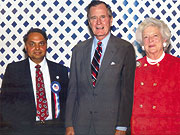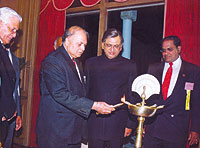|
Few Indians have promoted India and its interest in America more than Inder Singh of the Global Organization of People of Indian Origin (GOPIO). The president of this largest global body of the Indian diaspora has lived an India-centric life ever since making America his home in 1968. It was this man who brought Indians in Southern California together on a single platform through the Federation of Indian Associations (FIA).
And it was this man who organized the first-ever community celebration of Indian Independence and Republic Days in Southern California. As a representative of the Asian community in Southern California, he co-hosted President George Bush Sr twice.
| Way back in 1968 when he landed in Los Angeles to do his master’s degree in data processing, there were very few Indians in Southern California. “We were such a small community that everybody knew everybody else. Every month, about 100 Indians - Hindus, Muslims, Sikhs and Christians - from places as far as Arizona and San Diego used to come to the Vermont Sikh temple in Los Angeles for langar. I joined the temple committee after Spoony Singh, who owns the Hollywood Wax Museum, quit as vice-president. I remained active with that temple for a few years. We used to celebrate Vaisakhi as a religious event quietly,” he says, sitting on a lawns of his lush San Fernando Valley home with his wife Deepi Singh. |

FIRED BY BUSH: Singh draws inspiration from President Bush Sr. and his wife at a meet in California
|
However, in 1976 when someone suggested that Vaisakhi should be celebrated not only as a religious function but also as a cultural or harvest festival, Inder Singh decided to float the Punjabi Folk Cultural Society to organize community celebrations of Vaisakhi. “Over 1,500 people, including Jaswant Singh, Perry Lamba, Anup Loyal, Dr Rani Dargan, Suman Marwah, Kamlesh Chohan, Gurdip Grewal and Kumad Amar, took part in the first Punjabi cultural extravaganza here in 1977. The next year, we organized this show in Pasadena City College where about 1,800 people came. These celebrations continued till 1984 when the division within the community because of the Punjab problem, made it difficult for me to continue the annual tradition,” he narrates. His success in organizing Vaisakhi programmes brought Inder Singh an invitation from Dr Amy Catalin of UCLA to coordinate the first-ever, two-week-long gidha performance at the Smithsonian Institution. “That was as part of the Festival of American Folklife in 1985. Our gidha girls Leena Gill, Soina Dargan, Rachna Singh, Roina Dargan, Neeti Diwan and Neetu Malhotra gave performances that are remembered to this day,” he gushes.
|
When he reached California to do his master’s in 1968, Singh realised there were very few Indians in that state |
Inder Singh turned his attention to celebrating India’s national days. “In 1980, my son VJ happened to study with the son of a Los Angeles County supervisor. I lobbied with this official to get sanction for India’s Independence Day celebrations in the county and got it.”
Thus, in 1981 the first large-scale celebration of India’s Independence was held on the West Coast of America. “Over 5,000 people turned up for the day-long mela in downtown LA. The county gave us all facilities like stage, booths, security and parking, and continued for the next four years. County Supervisor Mike Antonovich used to preside over the evening functions. Even California Governor Dukemejian and his wife came (once) as did prominent Indians like Vijay and Ashok Amritraj, Kabir Bedi, Zubin Mehta and the Indian consul general.
|
"The Republican Party reflects Indian values of hard work, marriage and family life" |
Shifted to Artesia in 1988, this annual affair became a mega-show with thousands of Indian Americans, politicians and officials participating. However, when many members of the Indian American community of the San Fernando Valley complained that the distance of 60 miles to Artesia was too much, Inder Singh started another celebration of India’s independence Day in the valley in 2000. “Our first edition was attended by over 10,000. Many local elected officials, including Congressman Howard Berman, addressed the gathering. The Los Angeles Times, Daily News and two major TV networks gave us good coverage. I will be failing in my duty if I don’t name Kumar Jawa, Dr Parvin Syal, Dinesh Lakhanpal, Harshi Gill, Deepi Singh, Dr Bama Sridhar, Gurdip Saran, Mohini Lata Kumar, Karamjit Grover, Rajesh Pal Singh, Avtar Chadda and Rajesh Saini, all of whom made the day-long celebration a huge success. The Indian Association of San Fernando Valley now organizes the annual event, making it the regional center for India-American activities in the metropolitan Los Angeles area,” he says. After a pause, he goes back in time and says, “When we began celebrating Indian national days in 1981, we decided to merge various Indian associations to form the Federation of Indian Associations (FIA) of Southern California. I was its founder-president. In 1982, I joined hands with the East Coast-based National Federation of Indian American Associations (NFIA), which elected me its vice-president for the West Coast. In 1984, I was elected its joint secretary.”
| Inder Singh wears his affiliations with the Republican Party on his sleeve. “The party reflects Indian values of hard work, marriage and family life. I was vice-chair from the Asian community on the Reagan-Bush re-election team, and co-founder of the National Federation of Indian Republicans in the US,” he says. When he was appointed to the Republican Party’s Asian Advisory Board in 1992, he mooted and Asian Bush Brigade to woo voters. “The idea was approved by the Republican National Committee, with funds,” says Inder Singh, who was featured on Republican brochures, sitting alongside President Bush Sr. |

LAMP SHOW: Singh lights the lamp at the GOPIO meet in Mumbai in 2005. Present in the picture are Maharashtra Governor S.M. Krishna, GOPIO chairman Thomas Abraham (right) and former Trinidad PM Basdeo Panday |
When did he involve himself with the issues of the Indian diaspora?
Says Inder Singh: “It was during my presidency that the NFIA organized the first Global Convention of People of Indian Origin, which led to the formation of the Global Organization of people of Indian Origin (GOPIO). We met in New York for five days and decided to form GOPIO, with Thomas Abraham as its first president. Over the years, GOPIO has fought for the human rights of the Indians in Fiji, Sri Lanka and elsewhere. We were the first to propose to the government of India to give PIO cards and dual citizenship to overseas Indians.”
Since he took over as GOPIO’s international president in 2004, the organization has further expanded and held its meetings in New Delhi, New York, Brussels and Mumbai.
For him, the late Congressman Dalip Singh Saund will always remain the model Asian American in this country. To highlight Saund’s contribution, Inder Singh and like-minded Indians such as Dr Harvinder Sahota and Dr Krishna Reddy organized a function in January 2002 to mark the 45th anniversary of Saund’s entry to the US Congress. “Held in Los Angeles, this function was attended by Saund’s family and many Indian representatives from the US and Canada, including former British Columbia and current Canadian health minister Ujjal Dosanjh, Minnesota State Senator Satveer Chaudhary and Assemblyman Kumar Barve. At the gathering many proposals to honor the late Indian Congressman were mooted, including a commemorative stamp to mark the 50th anniversary of his election victory.”
“Six years ago, I wound up my professional life to devote all my time to issues and activities I have passion for. It is a new phase. After earning my degree, I had worked for 20 years in various capacities-from a programmer analyst to vice president-and then started my own systems development and networking consulting firm. In 1999, I called it quits. So, here I am,” he adds.
His mission is on.
|